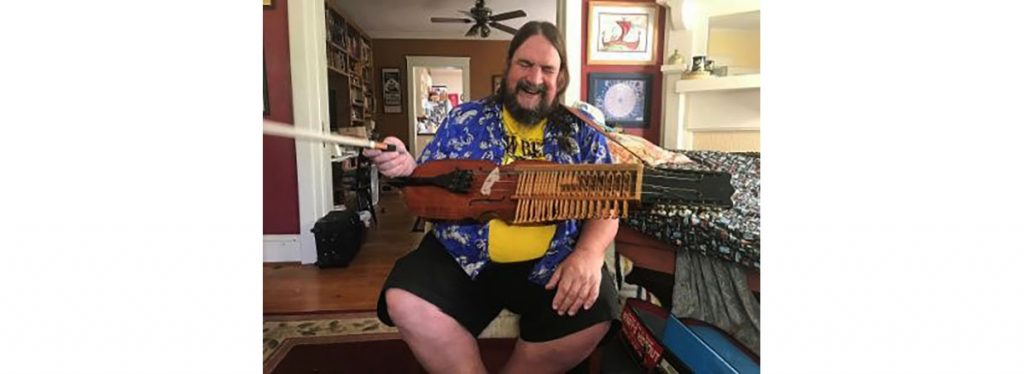
Many years ago, I was posted to Stockholm, Sweden as the cultural affairs officer in our embassy. Dealing with Swedish musicians and artists was part of my routine. Of special interest to me, personally, was the folk music scene in that country. Previously, I had lived in Argentina where my Swedish girlfriend I and attended the Swedish Lutheran church in Buenos Aires. The church’s pastor organized folk dancing classes. We got involved in that activity and eventually performed Swedish folk dances in public. I very much enjoyed the folk music sounds and was intrigued by the instruments used in the recordings we danced to. One of the musical instruments that caught my ear had a peculiar sound, very melodic and almost haunting. I learned that it was called a “nyckelharpa,” or in English, a keyed fiddle/harp.
(It is a traditional Swedish stringed musical instrument. Its keys are attached to tangents which, when a key is depressed, serve as frets to change the pitch of the string. The nyckelharpa is similar in appearance to a fiddle and structurally, it is related to the hurdy-gurdy employing key-actuated tangents to change the pitch.)
So, it was a surprise as I interviewed Simon Spalding for this article, when he produced a nyckleharpa from his collection of musical stringed instruments from around the world. In fact, Simon played a tune on it for me which brought back pleasant memories of Sweden.
“Now why,” I asked, “does a musician living in New Bern have a substantial array–a few dozen or more–of exotic instruments?” Simon, in his matter-of-fact way of talking, gave me a tour of his lifelong interest (passion seems more accurate) in music and especially his background in ethno-musicology.
Born in San Francisco, to parents he refers to as free spirits, he grew up around the heady environment of his parents’ “Beat Generation” of the North Beach neighborhood in San Francisco absorbing esoteric influences as part of his childhood. Because of this, Simon calls himself a “Second generation Beatnik,” rather than a hippie.
As his parents were active in the local theater movement, they introduced Simon to the theater stage at the early age of 8. He acted in many well know plays of the day and even performed in classics like, “Lysistrata,” the ancient Greek comedy by Aristophanes. “Pretty heady stuff for a little kid,” I told him. Obviously for Simon, he took all that in stride and parlayed his love of playing before audiences into his extensive musical career performing around the world from Carnegie Hall to the opera houses in Russia.
Simon began has musical journey at the age of ten when he started taking lessons on the violin and playing in the school orchestra. At 15, he was taking private lesson and honing his skill as a violinist and on the side taught himself to play the five-string banjo.
Concurrently, he developed a budding interest in unusual musical instruments and bought his first, an “Erhu,” a Chinese two-stringed bowed musical fiddle.
By 17, he was engrossed in learning and acquiring musical instruments. He bought his first Russian Balalaika and joined a Russian band playing a larger variation called a Contrabass Balalaika—characteristically, a large triangular wooden, hollow body, fretted neck and three strings instrument. That love affair with Russian music let to Simon join a balalaika band and concertize around the states for several years while still a teen.
Simon, as one would expect, studied ethno-musicology and got his BA in music at UC Berkeley in 1978. His studies set the stage for his long professional career in teaching, performing, composing, collecting rare instruments, museum keeper, and traveling as a guest speaker at prestigious venues in western and eastern Europe. His vast curriculum would literally fill up pages.
Arriving in North Carolina in 1989, he was hired to manage the Henry Hudson tour boat in Little Washington. From there, he moved to Wilmington performing and traveling to New Bern and other venues to play solo or with a band. For a period, he was in charge of music at the Tryon Palace, lecturing, and also picking up gigs in our town. Along the way, he formed numerous bands playing everything from rock, to oldies, to Irish music.
I first met maestro Spalding at the Neuse River Coffee Shop on Craven Street where he often played. He would show up spontaneously at musicians’ gatherings around New Bern such as Pickin’ and Grinin’ in River Bend and even sat in occasionally with blues great Big Jim Kohler. His versatility is amazing. He can transition from the balalaika to jazz/blues fiddle without a hitch. Wherever there is a musical event going on—big or small–you can count on Simon being there in person soloing or with one of his eclectic bands to entertain the public.
Without a doubt, Simon Spalding is the embodiment of the consummate musician. He has enriched the music scene in our town as much as any other musician that I have seen and heard in my 15 years living here. Without him we’d be in a different place music-wise. Whether entertaining or teaching stringed instrument as he often does, Simon is an asset in our community. Thankfully, we are sure to have him and his music to entertain us for many years to come. And I am ready for that.
See you down the road.
By Jerry Scott

